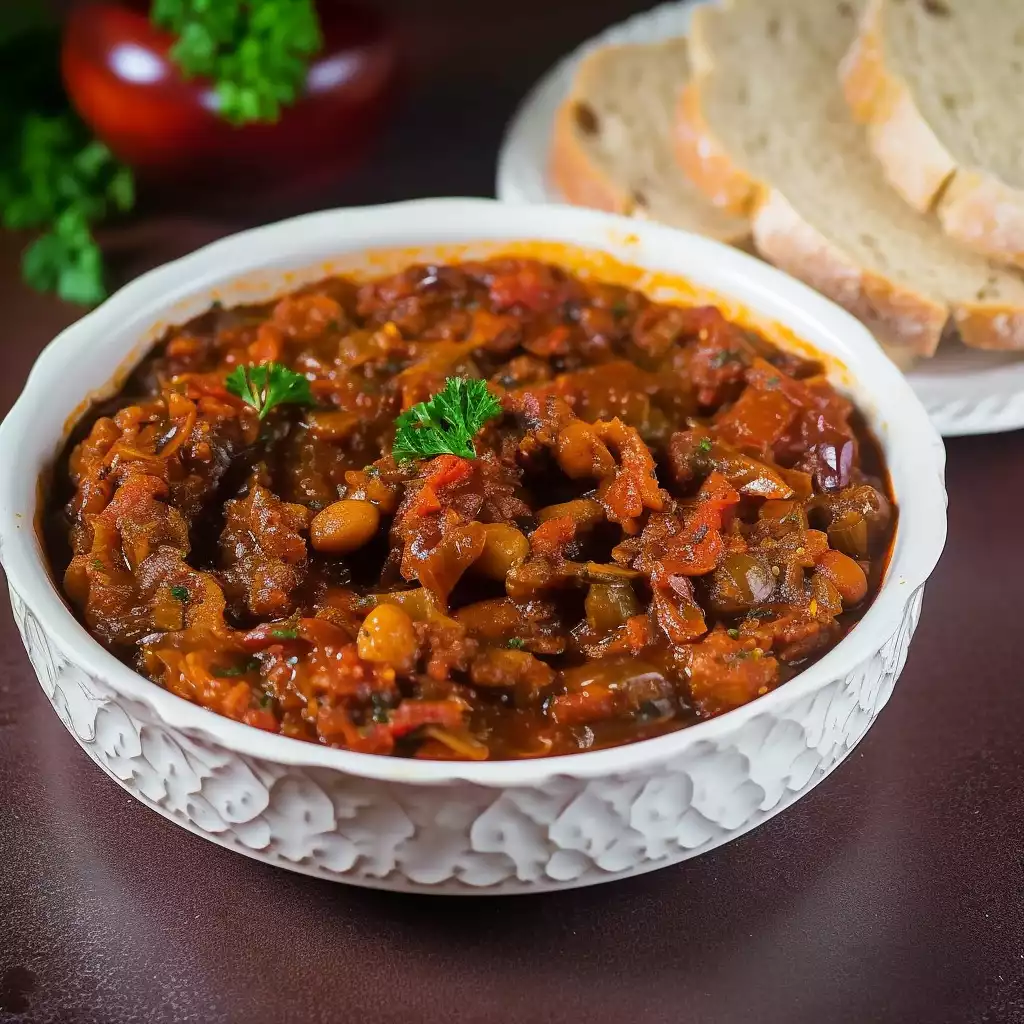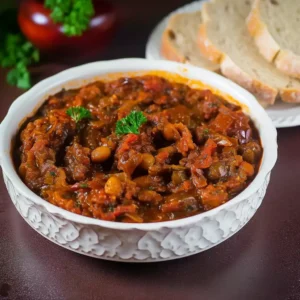
Moroccan Zaalouk, a dish as rich in history as it is in flavour, has its roots deeply embedded in the culinary traditions of Morocco.
This simple yet profound recipe brings together the humble eggplant, a staple in Moroccan kitchens, with a harmony of spices and ingredients that have been a part of Moroccan cooking for centuries.
The beauty of Zaalouk lies in its simplicity and adaptability. Traditionally, this dish is made with roasted or grilled eggplants, tomatoes, garlic, and a blend of aromatic spices, including cumin, paprika, and chili.
The eggplants are the soul of this dish, providing a creamy and soft texture that perfectly complements the tanginess of the tomatoes.
The difficulty level of Zaalouk is pleasantly low, making it an excellent choice for beginners or those who are short on time but still crave a taste of authentic Moroccan cuisine.
The process of preparing Zaalouk involves roasting eggplants and then simmering them with tomatoes and spices, resulting in a dish that is both heart-warming and satisfying.
What sets Zaalouk apart is its versatility. While the basic ingredients remain constant, there are numerous variations of this dish across different regions of Morocco.
Some versions include the addition of bell peppers, carrots, or even chickpeas, each lending its unique twist to the traditional recipe. This versatility not only speaks to the adaptability of Moroccan cuisine but also allows home cooks to experiment and personalize their Zaalouk to their taste preferences.
Furthermore, Zaalouk is not just a side dish; it can be served in various ways, making it a star in its own right. It’s commonly enjoyed as a dip with warm, crusty bread, as a spread in sandwiches, or even as a companion to grilled meats and fish. Its smoky, spicy, and slightly sweet profile adds depth and character to any meal.
This dish’s ability to bridge the gap between the exotic and the familiar is what makes it so appealing. Its ingredients are easily accessible, yet when combined, they create a flavour that transports you to the bustling streets and vibrant markets of Morocco.
Zaalouk is a testament to the country’s rich culinary heritage, a heritage that values the simplicity of ingredients and the art of bringing them together in perfect harmony.
Moroccan Zaalouk is more than just a recipe; it’s a culinary journey. It allows you to experience the essence of Moroccan cuisine without leaving your kitchen.
Whether you’re a seasoned cook or just starting, Zaalouk is a dish that promises to bring a piece of Morocco to your table, inviting you to explore and enjoy its warm, inviting flavours.
Expert Tip: For a richer flavour, let the Zaalouk sit for a few hours after cooking. This resting period allows the spices to infuse deeply into the eggplants, enhancing the overall taste.
Cooking is a delightful journey, and every journey needs the right companions. In the case of Moroccan Zaalouk, each ingredient plays a crucial role in creating a symphony of flavours. Let’s delve into why these specific ingredients are chosen and their possible alternatives.
Eggplants (Aubergines): Eggplants are essential for Zaalouk, offering a unique creamy texture and mild, slightly sweet taste. They absorb the spices beautifully, making them integral to this dish.
If eggplants are not your cup of tea or hard to find, courgettes (zucchinis) can be a great substitute, though they’ll bring a different texture and a slightly more pronounced flavour.
Ripe Tomatoes: The juicy, tangy nature of ripe tomatoes adds a necessary acidity and moisture to Zaalouk. They balance the richness of eggplants and bring a fresh, vibrant colour to the dish. In their absence, canned tomatoes can be used, though the freshness might be slightly compromised.
Onion: Onions form a flavour base in many Moroccan dishes, including Zaalouk. Their sweet, aromatic presence enhances the overall taste profile. Shallots could be an alternative, offering a more delicate, refined flavour.
Garlic: The pungency and warmth of garlic are critical in Moroccan cuisine. It adds depth and a kick that elevates the dish. If you’re not a fan of garlic or have dietary restrictions, a pinch of asafoetida could be an interesting alternative, though the flavour profile will change.
Olive Oil: Olive oil is not just a cooking medium; it’s a flavour enhancer. Its fruity, peppery notes complement the spices used in Zaalouk. If olive oil is not available, another vegetable oil could be used, but the distinctive flavour of olive oil will be missed.
Ground Cumin: Cumin’s earthy, slightly spicy taste is a hallmark of Moroccan cooking. It brings warmth and depth to Zaalouk. Caraway seeds can be used as a substitute, offering a similar but slightly more intense flavour.
Ground Paprika: Paprika adds a sweet, smoky undertone to the dish. Its vibrant colour also contributes to the visual appeal. If paprika is unavailable, a mild chili powder could be a substitute, though it will increase the heat.
Ground Chili: The role of chili in Zaalouk is to bring a gentle heat. It’s adjustable to suit your taste. For a less spicy version, sweet bell pepper powder can be used, or it can be omitted entirely for a mild dish.
Salt and Black Pepper: These seasonings are fundamental in highlighting and balancing all the flavours in the dish. They can be adjusted according to personal preference.
Fresh Cilantro Leaves: Cilantro adds a burst of freshness and colour, enhancing the dish’s appearance and flavour. If cilantro isn’t to your taste, parsley can be a mild, fresh alternative. Understanding why each ingredient is used in Moroccan Zaalouk not only helps in preparing this delicious dish but also opens doors to creativity.
You can tweak and twist the recipe according to what’s available or suited to your palate, making it your own unique version of this traditional Moroccan delight.
Expert Tip: Don’t skimp on the roasting of eggplants. Properly roasted eggplants are key to achieving the authentic smoky flavour of Zaalouk. Ensure they are tender and slightly charred for the best result.
Absolutely! While eggplants are traditional in Zaalouk, you can substitute them with courgettes (zucchinis) for a different texture and flavour. The key is to maintain the balance of spices and the overall cooking method to keep it close to the authentic taste.
Zaalouk can be enjoyed both hot and cold. Traditionally, it’s served at room temperature, making it a versatile dish that fits into any meal setting. Whether as a warm side dish or a cool dip, its flavours remain equally tantalizing.
Leftover Zaalouk can be stored in an airtight container in the refrigerator for up to 3-4 days. It’s one of those dishes that often tastes better the next day, as the flavours have more time to meld together. Just give it a good stir before serving.
Yes, Zaalouk can be frozen. Freeze it in an airtight container or a freezer-safe bag. When ready to eat, thaw it overnight in the refrigerator and then bring it to room temperature or warm it up slightly before serving.
Zaalouk is perfectly suitable for both vegans and vegetarians. It’s a plant-based dish that doesn’t contain any animal products, making it a great choice for those following these diets.
While Zaalouk is traditionally a vegetarian dish, you can add meat if you wish. Some people like to serve it with grilled chicken or lamb on the side. However, adding meat directly into the dish would significantly change its character.
Expert Tip: Experiment with spice levels. Moroccan Zaalouk is versatile, so feel free to adjust the amount of cumin, paprika, and chili to suit your taste. This customization makes the dish uniquely yours each time you prepare it.
Here are some more recipes for you to enjoy! If you my recipes don’t forget to rate and leave a comment.
If you have any recipe suggestions, please do not hesitate to ask me. A great way to stay in contact with me is through Instagram, Facebook, Twitter and YouTube. Don’t forget to tag me @CookwithNabeela in your recipe photos!

Subscribe now to receive my latest recipes directly in your inbox. Stay up-to-date and never miss out!

I love to cook! I want to share with you my favourite, delicious family-friendly recipes. I want to inspire you to create fantastic food for your family every day.
Add your first comment to this post